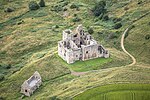Oxenfoord Castle
1782 establishments in ScotlandCategory A listed buildings in MidlothianHouses completed in 1782Inventory of Gardens and Designed LandscapesListed houses in Scotland ... and 1 more
Robert Adam buildings

Oxenfoord Castle is a country house in Midlothian, Scotland. It is located 1 kilometre (0.62 mi) north of Pathhead, Midlothian, and 6 kilometres (3.7 mi) south-east of Dalkeith, above the Tyne Water. Originally a 16th-century tower house, the present castle is largely the result of major rebuilding in 1782, to designs by the architect Robert Adam. Oxenfoord was the seat of the Earl of Stair from 1840, and remains in private ownership. It is protected as a category A listed building, while the grounds are included in the Inventory of Gardens and Designed Landscapes in Scotland.
Excerpt from the Wikipedia article Oxenfoord Castle (License: CC BY-SA 3.0, Authors, Images).Oxenfoord Castle
A68,
Geographical coordinates (GPS) Address External links Nearby Places Show on map
Geographical coordinates (GPS)
| Latitude | Longitude |
|---|---|
| N 55.8786 ° | E -2.9794 ° |
Address
Oxenfoord Castle
A68
EH37 5TY
Scotland, United Kingdom
Open on Google Maps










